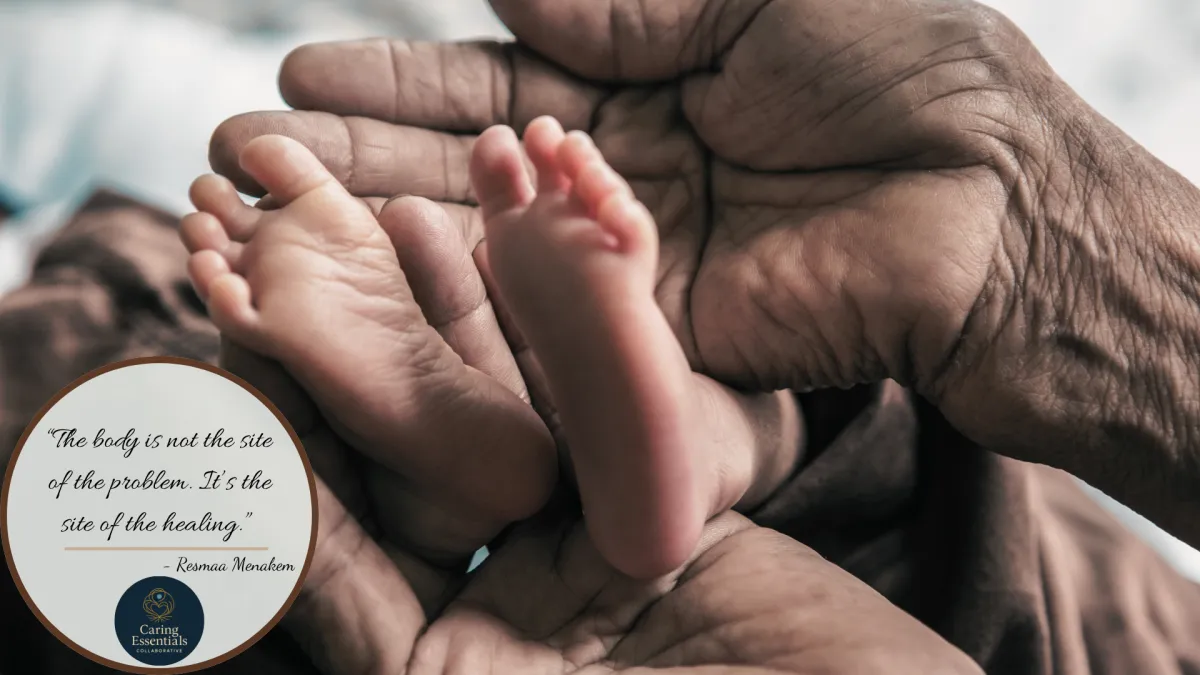
The Body Remembers: What My Grandmother’s Hands Teaches Us About Healing at Every Level of Care
“The body is not the site of the problem. It’s the site of the healing.” — Resmaa Menakem
The Body Remembers: What My Grandmother’s Hands Teaches Us About Healing at Every Level of Care
Healing Begins in the Smallest Bodies
The Continuum of Care — and the Continuum of Healing
When I first opened My Grandmother’s Hands by Resmaa Menakem, I felt something ancient stir. His words reached beyond the intellect and spoke directly to the body:
“Trauma decontextualized in a person looks like personality.
Trauma decontextualized in a family looks like family traits.
Trauma decontextualized in a people looks like culture.”
Those sentences landed like truth I had known all along. They name what I have witnessed for decades in the NICU, and beyond. Trauma is not a story of brokenness; it’s a story of protection. It is the body remembering danger and doing its best to survive.
This is as true for a premature infant as it is for a grieving parent, a burned-out clinician, or a divided society.
Healing Begins in the Smallest Bodies
In the NICU, trauma is often invisible. It hides in the baby’s shallow breaths, the mother’s trembling hands, the nurse’s clenched jaw. Yet beneath the monitors and protocols lies a shared longing; the need for safety.
Menakem’s work reminds us that the body is not the site of the problem; it is the site of the healing.
Every gentle touch, every steady voice, every pause for connection helps the nervous system remember that safety is possible.
This is the essence of Trauma-Informed Developmental Care (TIDC): creating conditions where stress becomes tolerable, connection becomes medicine, and repair becomes possible.
The Continuum of Care — and the Continuum of Healing
Healing does not end when the baby goes home.
The same nervous systems that begin in the NICU grow into families, schools, workplaces, and communities. When those early experiences are shaped by safety and attunement, they ripple forward strengthening the threads of empathy, resilience, and belonging that hold society together.
But when those systems are shaped by fear, hierarchy, or neglect, the pattern repeats: a stressed clinician becomes a withdrawn parent; an unsupported parent becomes a reactive community member; a disconnected community becomes a divided nation.
In this way, TIDC is not simply a healthcare framework, it’s a blueprint for human civilization.
Clinicians, Caregivers, and Collective Healing
Menakem challenges us to look at how trauma lives in systems; in bodies of power as much as in individual bodies. Healthcare is not immune. When we normalize exhaustion, suppress grief, or treat efficiency as the highest virtue, we reenact the very patterns we seek to heal.
Trauma-informed care requires that we become regulated bodies; that we learn to notice, name, and nurture our own nervous systems. Healing-centered leadership isn’t soft; it’s sovereign. It is the act of reclaiming presence in a world that rewards disconnection.
From the NICU to the Nation
Menakem calls us to “build culture around healing rather than punishment.” Imagine if that became our collective north star. If every institution, from healthcare to education to government, were guided by the same principles that define developmental care: safety, trust, collaboration, empowerment, and respect.
Because when we honor the humanity of a preterm infant, we are practicing the same muscle required to honor the humanity of one another. When we learn to co-regulate in crisis, we are learning the very skills democracy demands.
The NICU, then, is not just a medical unit, it’s a microcosm of what is possible when care becomes conscious.
The Heart of It All
Healing begins in the body.
So does justice.
So does love.
If we can learn to listen, to the trembling of a newborn, to the tension in our own shoulders, to the collective sigh of a world that is weary but willing, then we can begin to weave something new.
A healthcare system that heals.
A family that feels safe.
A society that remembers how to belong.
Because healing the world begins the same way it begins for every baby in the NICU:
with one steady breath, one open heart, and one human being choosing to meet another with presence.
Reflection Invitation
Where does your body hold tension when you witness suffering?
What would it mean to meet that place with compassion — not judgment?
And what might happen if every act of care, in every setting, became a moment of remembering our shared humanity?
Caring Is Essential
Take care and care well,
Mary
